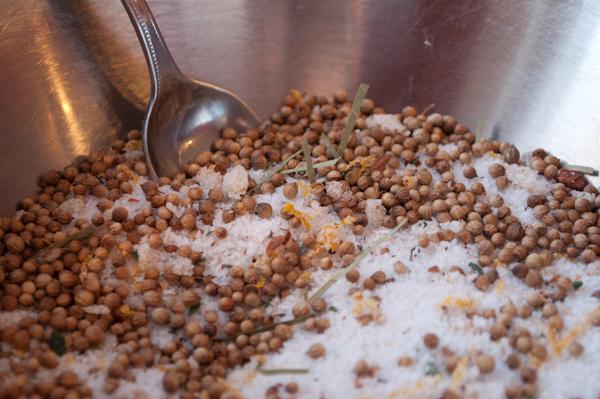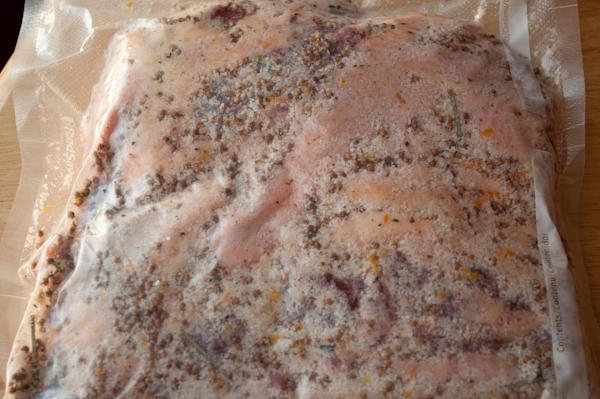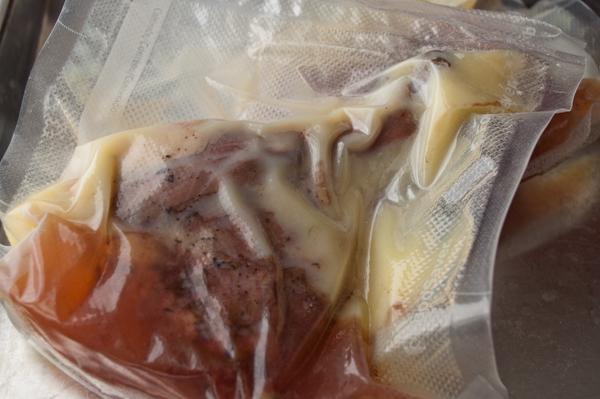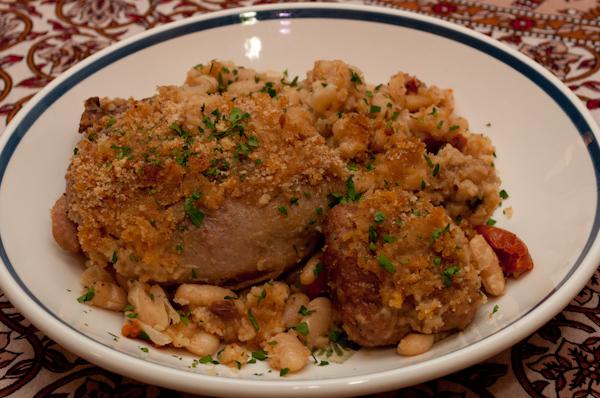-
Posts
1,890 -
Joined
-
Last visited
Content Type
Profiles
Forums
Store
Help Articles
Everything posted by mkayahara
-
Good point. I figured I'd be OK moving up to 6 quarts from the 4 quarts recommended in the recipe. I'm not sure I have a bigger pot I'd feel comfortable caramelizing sugar in...
-
Last night I tried making the sponge toffee from Chocolates and Confections At Home, as listed upthread. What a mess! As soon as I added the baking soda, the whole thing bubbled up so high and vigorously that it overflowed the 6-quart pot I was cooking in and ended up all over the stove top. Can anyone speculate as to what I did wrong? I'm thinking it's likely one of two things: I overcooked the syrup, taking it to about 315 F rather than 310 as specified, and I'm not sure I waited long enough for the bubbling to settle down before adding the baking soda. Any help would be appreciated! (Sadly, the final product that I did get - though remarkably airy - isn't usable, because I burned the sugar in overcooking it, and the vigorous bubbling meant that I wasn't able to thoroughly mix in the baking soda, so the flavour is... not good.) Edit: To clarify, I realize that the answer is probably "do what the recipe says next time," but I'm curious which of the two errors is responsible for the overflowing, or if it's both, or something else entirely.
-
Good question. I'm sure there's some room for overlap here; often, when riffing on a cocktail, I think that ends up being reflected in the name. Well, I think that's the point: ratios like these aren't meant to restrict every cocktail with vermouth that you make, but simply to give you a template to play around with when you've got a bottle of, say, dry Madeira kicking around and aren't quite sure what to do with it. This isn't to say there are no other ways to mix cocktails with fortified or aromatized wines, but it can give you a good starting point... and you never know when you're going to hit the jackpot. Well, since I'm an amateur and not a professional, I'm certainly not going to take offense at this! Maybe some of the (other?) professionals around here can offer an opinion on whether these types of ratios are useful?
-
It seems like a lot of no-fail cocktail ratios have been coming up around here lately. I'm thinking of the New Esquire Cocktail discussed here, and Boudreau's Golden Ratio here. On top of that, I've seen mentions of Wondrich's ratio of 1 oz. fortified/aromatized wine, 2 oz. spirits, 1 tsp. liqueur, 2 dashes bitters. And would the Last Word and its myriad variations count, or is it too specific? Of course, I think if you set out to break these ratios, you can, by using strong, clashing ingredients. And sometimes they're just nothing to write home about (I did Boudreau's Golden Ratio with blanco tequila, white Lillet, and Drambuie a couple of weeks ago... meh.) But on the whole, they're very serviceable. What other no-fail ratios do you use?
-
Does that mean you make the cooks under you cook over a wood stove before you let them near the gas burners? Or make all their purees with a food mill before you let them use the blender? There is some sense to learning foundations of cooking before trying advanced techniques that draw on more basic skills. But sometimes technology takes a quantum leap forward, and the old techniques simply become obsolete - in other words, sometimes, the foundations, the points of reference, change.
-
Another thing I'd be worried about is the heat required to hydrate and dissolve many hydrocolloids, including gelatin. "Cooked" wine has a very different flavour from the raw thing, in my experience.
-
Surely I'm not the only one cynical enough to believe that under-sized serving sizes are purposefully designed to make people think they're consuming fewer calories than they are? Especially on a high-calorie-density item like potato chips, the intention seems to be for people look at the label and say, "Gee, only 120 calories per serving!" And then proceed to eat 4 servings at a time.
-
Should I be ashamed to admit that tonight's tipple was a Black Russian? There's just something about these simple spirit + liqueur combos that says après-ski (-snowboard, in my case) to me.
-
To add to Chris's question, is there a simple way to measure the sugar in a commercial product? Is a refractometer required? Presumably a hydrometer is insufficient, since the alcohol will mess up the density... or is there an easy calculation you can do, since the alcohol content is listed on the front of the bottle?
-
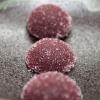
"Modernist Cuisine" by Myhrvold, Young & Bilet (Part 1)
mkayahara replied to a topic in Cookbooks & References
And we have an answer: 6,000 copies. -

"Modernist Cuisine" by Myhrvold, Young & Bilet (Part 1)
mkayahara replied to a topic in Cookbooks & References
I think that's one of the great things about how this book is written: any cook at nearly any level can learn something from it. Especially if you're an engineer, you'll appreciate the way it's written. I think you can quite easily take from it what you want, and as you learn more, go back and mine it for even more in-depth information. -
I think you'll find that's spelled "Jagdwurst." Etymologically speaking, they mean the same thing (hunter's sausage vs. hunting sausage). The Wikipedia article calls it a "cooked" sausage, but the ones my local sausage-maker makes are dried. I think he's actually Polish, but I can ask him on Saturday what kind of meat he puts in it...
-

"Modernist Cuisine" by Myhrvold, Young & Bilet (Part 1)
mkayahara replied to a topic in Cookbooks & References
I'm honestly surprised at the rank on Amazon. Not because I don't think the interest is there, but because I didn't think the interest and disposable income would necessarily overlap in enough of the population for this kind of result. I'm really finding myself wondering about the size of the first print run... -
I guess I'll add Ransom to the list of things to buy next time I'm in the US. Sigh. Please tell me its name does not reflect its price point?
-
Uh... I hacked it together? Basically, I made the confit, made some garlic sausage patties, cooked the beans with some unsmoked bacon (the savory cure from Charcuterie) and aromatics, then layered it all in a pot, along with some onions and some roasted, previously frozen Roma tomatoes, and topped with bread crumbs. That's pretty much all cassoulet is, right? The cooking liquid at the final stage was the drained cooking liquid from the beans along with that wonderful jelly from the confit, plus a little bit of white wine that I reduced first. Actually, about that wine. For some reason, I decided to go out on a limb and buy a locally produced Aligoté. I've had Aligoté maybe once before in my life, but it was among the better wine matches I've ever served. It just made all the flavours pop. Home run.
-
I don't think I've ever had the Ransom Old Tom, Chris, but I understand it's pretty idiosyncratic? I've only got the Hayman's, which I think would end up too sweet. Now you've got me wondering, though, how some genever would play with these flavours, maybe split half-and-half with a London Dry? Hmm...
-
One item from Modernist Cuisine that really stuck with me was the famous finding that duck confit doesn't need to be cooked fully submerged in fat. I've been dying to see the recipe for confit that ended up being published, and when I got access to the online review copy, it was one of the first things I looked up. Essentially, it's a basic sous vide confit, but since I've never done duck confit sous vide before, I thought it would be a good place to start. (Until recently, I couldn't get duck legs unless I bought the rest of the duck, too. I still have four frozen duck carcasses to turn into stock from the last time I made confit. I'm thinking they'll end up in the pressure cooker, once it arrives.) Anyway, I started off by mixing up the cure: I made only a small batch - enough for the four duck legs I had. Some of the spices are in such small quantities, though, that I had to use my precision scale to measure them out. I'm not sure all the flavours came through in the end, but they were competing with a lot, as you'll see. Next, the duck legs get vacuum sealed with the cure for 10 hours. Then they're unsealed, rinsed and patted dry. Because I misread the recipe, this happened at night. I thought the next step was to cook them for 12 hours, but it turned out to be only 8, so instead of staying up late or getting up early, I just let them hang out in the fridge overnight, then sealed them with duck fat and put them in the water bath the next morning. After 8 hours at 82 degrees, followed by a quick dip in an ice bath, they looked more or less like this: That jelly you can see in the bag? That stuff has the texture of a superball. The recipe calls for the legs to be reheated in a water bath, then crisped in a frying pan and served with potatoes that are also cooked in a water bath with duck fat, but I had bigger and better plans. I'm not sure how "authentic" my cassoulet was, but it was darn tasty! Anyway, this is now officially my go-to recipe for duck confit. It was far and away the best I've ever made or eaten. The texture was perfect, and the flavour (despite having to compete with all the other flavours in the dish) was great. And honestly, aside from mixing the cure, which can be done in bulk, I found this process considerably easier and less messy than a traditional confit.
-
This is so true about xanthan. I misplaced a decimal once, and ended up thickening a sauce with 1% xanthan rather than 0.1%. The resulting texture is not one I would care to experience again.
-
Boy did I read that wrong the first time around.
-
I hesitate to beat a dead horse here, but I just realized that there's another term I find funny when home cooks use it: menu. To my mind, a menu involves several different options that allow me to customize my meal as I like. So I don't plan a menu at home, I just decide what I want for dinner!
-
Foil can definitely react with acidic foods; I generally try not to store anything with tomatoes in contact with foil in the fridge over long periods. (Lasagna, I'm looking at you...) But I generally don't use foil with my braises, so it's never come up in that context for me. I just use the lid that came with the pot or a parchment cartouche. I don't know that I'd ever bother with both.
-
Oh, I'm not sure I agree with that. To my mind, in steaming, the food shouldn't be in contact with the liquid, whereas in braising it is. I would say braising involves several different aspects: some heat transferring directly from the liquid to the meat, some through steam, and some through the condensation that collects on the lid and drips back down.
-

"Modernist Cuisine" by Myhrvold, Young & Bilet (Part 1)
mkayahara replied to a topic in Cookbooks & References
I'm no expert, but the age of the rice makes a difference. Agreed with Jenni. Do you find that a single batch of rice has this kind of variability? I've never had my rice come out crunchy unless I put in the wrong amount of water, or let it boil for too long before covering. I guess this question just goes to show that, although it covers a lot, Modernist Cuisine can't cover literally everything. In this case, I'd bet your answer could be found in McGee... which just goes to show that Modernist Cuisine doesn't obviate that classic work. -
It does evaporate, but in so in doing, it causes evaporative cooling, which helps regulate the surface temperature.
-
So, a Sidecar with pre-phylloxera Cognac is permissible? Actually, I think I'd probably go Negroni. A bitter drink for a bitter moment.


